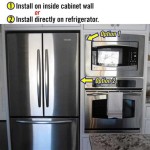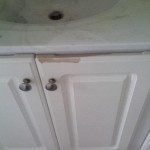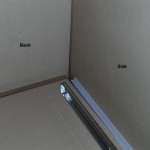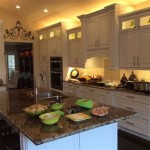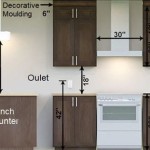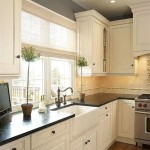How to Paint Over Wood Kitchen Cabinets: A Comprehensive Guide
Painting wood kitchen cabinets is a cost-effective method to refresh the look of a kitchen without the expense and disruption of a full remodel. Properly executed, a paint job can transform dated or worn cabinets into a centerpiece of the kitchen's design. However, achieving a professional and durable finish requires meticulous preparation, the right materials, and a methodical approach. This article provides a detailed guide on how to paint over wood kitchen cabinets, ensuring a long-lasting and visually appealing result.
Key Point 1: Preparation is Paramount
The success of any paint project hinges on thorough preparation. This stage involves cleaning, sanding, and priming the cabinets. Neglecting any of these steps can lead to paint adhesion issues, uneven surfaces, and a compromised final appearance. This process also includes removing hardware and choosing the most appropriate workspace.
Removing Cabinet Doors and Hardware: The first step is to remove all cabinet doors and drawers. Label each door and drawer front with its corresponding cabinet location. This can be done using painter’s tape and a permanent marker. Remove all hardware, including hinges, knobs, and handles. Store the hardware in labeled containers to prevent loss or confusion during reassembly. This step is essential for achieving a uniform paint finish across all surfaces.
Cleaning the Cabinets: Over time, kitchen cabinets accumulate grease, grime, and food splatters. A thorough cleaning is crucial for proper paint adhesion. Begin by wiping down all surfaces with a degreasing cleaner, such as trisodium phosphate (TSP) or a TSP substitute. Follow the manufacturer's instructions for dilution and application. For heavily soiled areas, a more concentrated solution may be necessary. Rinse the cabinets thoroughly with clean water to remove any residue from the cleaner. Allow the cabinets to dry completely before proceeding. This step removes contaminants that would prevent the paint from adhering properly.
Sanding the Surfaces: Sanding creates a slightly rough surface that allows the primer and paint to bond effectively with the wood. Use a medium-grit sandpaper (120-180 grit) to scuff the existing finish. The goal is not to remove the entire existing finish, but to create a profile for better adhesion. Sand all surfaces lightly, paying particular attention to edges, corners, and areas with existing imperfections. After sanding, use a tack cloth or a vacuum with a brush attachment to remove all sanding dust. A dust-free surface is critical for a smooth and flawless paint finish. Sanding provides the necessary tooth for the primer to adhere to the existing finish.
Addressing Imperfections: Examine the cabinets for any imperfections, such as dents, scratches, or cracks. Fill these imperfections with wood filler. Apply the wood filler according to the manufacturer’s instructions. Allow the filler to dry completely, and then sand it smooth with fine-grit sandpaper (220 grit). Feather the edges of the filled area to blend seamlessly with the surrounding surface. Addressing imperfections ensures a smooth and uniform paint finish.
Setting up a Workspace: Choose a well-ventilated workspace that is protected from dust and debris. Cover the floor with drop cloths or plastic sheeting to protect it from paint spills. Use painter’s tape to mask off any areas that you do not want to paint, such as the inside of cabinet frames or adjacent walls. Adequate ventilation is essential for safety and proper paint drying.
Key Point 2: Priming for Optimal Adhesion and Finish
Priming is a critical step in painting wood cabinets. Primer provides a uniform surface for the paint to adhere to, seals the wood, and prevents tannins from bleeding through the paint. Selecting the right primer ensures that the topcoat will have the best possible bond, maximizing the lifespan of the paint job. Furthermore, the right primer can help to create a smooth and even surface for the paint to adhere to. There are different types of primer available and choosing the best one for the job will help ensure top results.
Selecting the Right Primer: Choose a high-quality primer specifically designed for wood surfaces. Oil-based primers are excellent for blocking stains and tannins, but they require mineral spirits for cleanup and can have a strong odor. Latex primers are water-based, easier to clean up, and have a lower odor, but they may not be as effective at blocking stains. Shellac-based primers are also an option. They are very effective at blocking stains and odors and dry very quickly. However, they can be more brittle than other primers and require denatured alcohol for cleanup. Selecting the right primer will depend on the specific needs of the project and environmental considerations.
Applying the Primer: Apply the primer in thin, even coats using a high-quality brush or roller. Use a brush for corners, edges, and detailed areas, and a roller for larger flat surfaces. Work in the direction of the wood grain. Avoid applying the primer too thickly, as this can lead to drips and runs. Allow the primer to dry completely according to the manufacturer’s instructions. Drying times can vary depending on the type of primer and the ambient temperature and humidity levels. Following the manufacturer's instructions is important for achieving proper adhesion.
Sanding the Primer: Once the primer is dry, lightly sand the primed surface with fine-grit sandpaper (220-320 grit). This will smooth out any imperfections and create an even better surface for the paint to adhere to. Remove all sanding dust with a tack cloth or a vacuum before proceeding. This step is crucial for achieving a professional-looking paint finish. Sanding after priming ensures that the surface will be as smooth as possible.
Applying a Second Coat of Primer (If Necessary): If the cabinets have particularly dark or stained wood, or if the first coat of primer does not provide adequate coverage, apply a second coat of primer. Follow the same application and drying procedures as with the first coat. Two coats of primer may be necessary to fully block stains and ensure uniform coverage, especially with darker woods.
Key Point 3: Painting Techniques and Application
The application of paint directly impacts the final appearance and durability of the painted cabinets. Using quality paints, appropriate tools, and proper techniques is essential for achieving a smooth, even, and long-lasting finish. The choice of paint is important as well. There are products made specifically for painting cabinets and using the right paint will help ensure that the outcome will be more durable.
Selecting the Right Paint: Choose a high-quality paint specifically designed for cabinets and trim. Alkyd or acrylic-alkyd paints are durable, offer excellent coverage, and provide a smooth, washable finish. Latex paints are also a good option, but they may not be as durable as alkyd paints. Consider using a paint with a semi-gloss or gloss finish, as these finishes are easier to clean and more resistant to moisture and stains. The choice of paint will depend on personal preference, budget, and desired level of durability.
Applying the Paint: Apply the paint in thin, even coats using a high-quality brush or roller. Use a brush for corners, edges, and detailed areas, and a roller for larger flat surfaces. Work in the direction of the wood grain. Avoid applying the paint too thickly, as this can lead to drips and runs. Apply a small amount of paint at a time and spread it evenly over the surface. Overlapping strokes can cause unevenness and imperfections. Taking your time with multiple thin coats is better than doing one thick coat.
Sanding Between Coats: After each coat of paint has dried completely, lightly sand the surface with fine-grit sandpaper (320-400 grit). This will smooth out any imperfections and create an even better surface for the next coat of paint to adhere to. Remove all sanding dust with a tack cloth or a vacuum before proceeding. Sanding between coats is important for achieving a professional-looking paint finish, especially with darker color paints.
Applying Multiple Coats: Apply at least two coats of paint, allowing each coat to dry completely before applying the next. Additional coats may be necessary to achieve full coverage and a uniform finish, especially when painting over dark colors. Follow the manufacturer’s instructions for drying times between coats. Proper drying time allows the paint to harden and adhere properly, which contributes to greater durability.
Reassembling Cabinets and Hardware: Once the final coat of paint has dried completely, carefully reattach the hardware and reinstall the cabinet doors and drawers. Ensure that all hardware is securely fastened. Inspect the finished cabinets for any imperfections or touch-ups that may be needed. Take care when reassembling to avoid scratching or damaging the newly painted surfaces. Reinstalling hardware may involve new screws or different placement depending on the existing holes.
By following these detailed steps, it is possible to achieve a professional-looking paint finish on wood kitchen cabinets. Patience, attention to detail, and the use of quality materials are essential for a successful outcome.

Tips Tricks To Paint Honey Oak Kitchen Cabinets Cottage Living And Style

Diy Painted Oak Kitchen Cabinets Makeover

Best Paint For Kitchen Cabinets 24 Brands Blind Tested 2024

How To Paint Kitchen Cabinets Forbes Home

How To Paint Fake Wood Kitchen Cabinets Simple Made Pretty 2024

How To Paint Kitchen Cabinets The Love Notes Blog

How To Paint Kitchen Cupboard Doors The Hub

How To Paint Oak Cabinets White Best Diy Guide 2024

Tutorial Paint A Wooden Kitchen Cabinets Bathroom Ideas

Painting White Kitchen Cabinets To Look Like Wood Repainting Remodel
Related Posts

